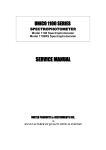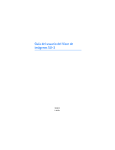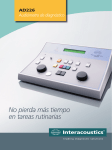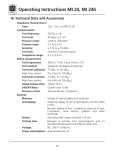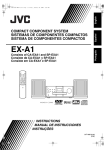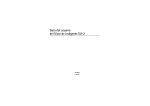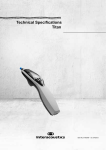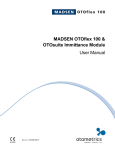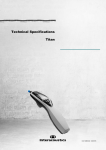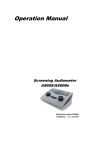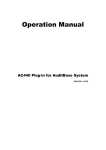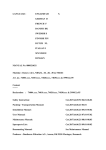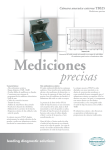Download Clinical Impedance Audiometer AZ26
Transcript
Clinical Impedance AZ26 Audiometer AZ26 Applications The AZ26 clinical impedance audiometer is built to meet the demands of clinics and hearing specialists who require a comprehensively specified middle ear analyzer. Tympanometry with a range of pressure limits is available together with an extensive test battery of acoustic reflex tests which include reflex decay and latency measurement. Eustachian Tube Function may be evaluated even with a perforated eardrum. To permit the easy checking of hearing thresholds, an air conduction audiometer is incorporated within the AZ26. A total of 40 internal memories are available for storage of the various test results. All testing can be performed manually or automatically and preprogrammable test sequences may be run automatically by the selection of a single button, thus providing quick and easy diagnostic evaluation. To ensure easy and accurate diagnosis, all test results are presented on-line as clear graphical records on the high resolution LCD screen. Printouts are available either using the fast built-in thermal printer or via connection to a PC. Tympanometry When performing tympanometry in manual mode the pressure can be adjusted using the precision rotary control. This ensures the operator accurate adjustment. In automatic mode, pressure limits and pump speed can be preset from a range of values. All results are displayed on-line and may be shown in either a compensated or non-compensated format. Complete print outs are available also for manually obtained tympanometry curves. Probe System The probe design of the AZ26 has been optimised for easy handheld operation as well as for use with the clinical headband. When used with the headband the probe tip itself can be detached enabling self-suspended positioning in the ear. This arrangement provides the greatest possible accuracy which is particularly important in the clinical evaluation of small deflection reflexes and in decay recording. Fitting the eartip to the ear canal is assisted by status indicators on the instrument’s LCD screen as well as on the probe itself. Reflexes Acoustic reflexes may be recorded ipsilaterally or contralaterally using a wide range of stimuli which includes various types of noise. Screening procedures as well as advanced procedures revealing threshold and reflex growth, are available as automatic test modes. Mixing manual reflex testing with an automatic reflex test sequence is possible, and ample memory is available, allowing storage of up to 16 reflexes per ear. Pressure offset may be applied. Latency A very detailed recording of the first 300ms of the reflex, following stimulation, can be displayed for evaluation. The latency time is automatically calculated. Both ipsi- and contralateral stimulation are available. Windows Based Software Computer Connection The AZ26 is equipped with RS232C or interconnection with a suitable computer. The Windows based software described above w enable a PC to be used for monitoring the t results, as well as providing printing and stor facilities. Decay Audiometry Custom Made Automatic 10 second or 30 second decay tests are available with ipsi- or contralateral stimulation. The resulting decay value is then calculated and displayed. An air conduction audiometer is provided for determining hearing threshold either manually or by using a patient controlled automatic test procedure. The AZ26 is very easy to operate in both the however, not restricted to working with the p tory default settings. If required, test parame tailored to individual requirement by modifyi ETF 1 Special Eustachian Tube Function for ears with unperforated eardrums can be evaluated by recording three tympanograms on the same screen. This method uses the William’s procedure. Four different automatic test sequences may be easily programmed into the AZ26. Use of these predetermined procedures enables fast and reliable testing which may, if required, be performed by an assistant. Automatic Tympanometry Pump speed and pressure limits, as well as the direction of pressure sweep, may be changed to meet specific requirements. Special - An Automatic Test Sequence Four different test sequences may be programmed by the user. In each test sequence the user has complete freedom in tailoring the procedure to meet desired characteristics. Using this facility it is possible to test both ears consecutively and to have a printout automatically produced upon completion of the tests. This highly flexible system can provide time saving yet accurate procedures in the clinic. ETF 2 For ears with perforated eardrums the Toynbee manoeuvre can be employed to evaluate the Eustachian Tube. Automatic ETF Tests Pressure limits and timing characteristic can be modified as requested. The ETF1 test provides three tympanograms for easy comparison. It is easy to select one of the test sequences pre-programmed by the user, to meet a specific requirement. e • PrintView enables monitoring of the AZ26 and the printing of test results. In developing this software maximum attention has been given to provide a program which is easy to use. • IaBase95 is similar to PrintView but incorporates a database for general pa-tient data and hearing aid information. • NOAH hearing aid fitting software may also be used for storing data from the AZ26. The IA-NOAH-Imp Module from Interacoustics is required for this purpose. will est age c Tests manual and automatic modes. You are, re-set automatic procedures in their facters and automated test routines can be ng the user accessible set-ups. Automatic Audiometry The automatic test procedure is performed in accordance with the International Standard ISO 8253-1. A 2 out of 3 or a 3 out of 5 response criteria may be assign-ed to this automatic procedure. Automatic Reflex Test The set-up parameters for the automatic reflex test allow complete freedom in assigning stimuli and intensities for up to a maximum of 8 reflex tests per ear. In addition to pre-set stimulation levels, a number of test protocol options are available. One of these is particularly suitable for the evaluation of reflex growth as well as for pinpointing the reflex threshold. Each stimulus can be assigned to ipsior contralateral presentation as required. The tympanogram is displayed here non compensated with a 3 ml scaling Detailed reflex recording - also observe the other recorded reflexes. A group of reflexes displayed for easy evaluation of reflex growth. The reflex decay test showing the actual recording and the decay as a percentage. The reflex latency test provides accurate detail and calculates latency time. AZ26 Specifications Standards Safety: EN 60601-1, class 1, Type B Impedance: EN 61027/ANSI S3.39, Type 1 Audiometer: EN 60645-1/ANSI S3.6, Type 4 0123 Approved for Medical CE marking by TÜV. Identification No. 0123. Calibration: Impedance: EN 61027/ANSI S3.39 Audiometer: ISO 389-1 Calibration is performed via the instrument’s front panel and is stored in a permanent memory. Tests: Tympanometry: Manual or automatic. Eustachian Tube Test: Manual or automatic. Normal eardrum or perforated eardrum. Reflexometry: Including decay and latency tests. Automatic or manual. Automatic reflex detection. 16 tests per ear. Audiometry: Manual or automatic. (Patient controlled Hughson Westlake test according to ISO 8253-1). Impedance: Type 1. Manual or automatic control. Probe Tone: 226 Hz, +/- 1% 85 dB SPL + 1.5 dB. Harmonic Distortion: Less than 5%. Air Pressure Control: Manual or automatic. Pressure Range: -600 to +300 daPa. Maximum Limits: -800 daPa to +600 daPa. Pressure Accuracy: 10% or 10 daPa. Compliance Range: 0.1 to 6.0 ml. Compliance Accuracy: + 5% or 0.1 ml. Frequencies and Maximum Intensities: Hz 250 500 1000 2000 3000 4000 6000 8000 WB HP LP Ipsi. dB HL 110 110 110 100 100 110 110 110 Contra dB HL 90 100 120 120 120 120 120 100 120 120 120 Audiometry dB HL 90 100 100 100 100 100 100 100 Ipsilateral Stimulation: Frequencies: 500, 1000, 2000, 3000, 4000 Hz. Noise: Wide Band, High Pass, Low Pass. Intensities: See table. Frequency Accuracy: + 3%. Harmonic Distortion: Less than 3%. Contralateral Stimulation: Frequencies: 250, 500, 1000, 2000, 3000, 4000, 6000, 8000 Hz. Noise: Wide Band, High Pass, Low Pass. Intensities: See table Frequency Accuracy: + 3%. Harmonic Distortion: Less than 3%. Step Size: 5, 2, 1 dB. Step Accuracy: 0.5 dB. Compliance Accuracy: + 5% or 0.02 ml. Reflex Decay: Stimulus duration: 10 or 30 seconds. Stimulus: as above. Reflex Latency: Manual or in automatic set-up. Audiometer: Type 4. Frequencies: 250, 500, 1000, 2000, 3000, 4000, 6000, 8000 Hz. Intensities: See table Frequency Accuracy: + 3%. Harmonic Distortion: Less than 3%. Auto Threshold Determination: Modified Hughson Westlake (according to ISO 8253-1). Built-in Printer: Thermal printer. Paper width: 112mm Computer Communication: Built-in RS232C input/output computer interface. Power: 100, 110, 120, 220, 230 or 240V, AC 50/60 Hz. Dimensions: L x W x H: 48 x 40 x 16 cm / 19 x 16 x 6 inches. Weight: 9.5 kg / 21 lbs. Air Freight Packing: 76 x 55 x 25 cm / 30 x 22 x 10 inches. Gross weight: 14.0 kg / 31 lbs. Consumption: Max. 60 VA. Construction: Painted metal cabinet. Ordering information Included Parts TDH39 Earphone and Headband Probe System BET50 Complete Set of Eartips Power Cable: 110 or 230 V, please specify PCR-AZ26 Dust Cover 3 Rolls of Recording Paper TPR26 Optional Parts APS2 Patient Signal TPR26 Recording Paper AZE26 Set of Eartips (Mushroom) ATE22 Set of Eartips (Parachute) CAT-222 Calibration Unit, 0.2 + 5 ml CAT-227 Calibration Unit, 0.2-0.5-1-2-34 and 5 ml IES-2 Impedance Ear Simulator Included Documentation Unpacking and Installation Instructions Operation Manual with diagnostic evaluation tools CE Multilingual Instruction for Use Service Manual Computer Connection IFC59 (25 pins) Computer Cable IFC69 (9 pins) Computer Cable PrintView software IaBase95 software IA-NOAH-Imp module for NOAH IA-PAX-Imp module for PAX Sales and Service in your area: Manufactured by: Interacoustics Phone: +45 6371 3555 Fax: +45 6371 3522 e-mail: [email protected] Mail: Interacoustics, DK-5610 Assens, Denmark www.Interacoustics.dk






